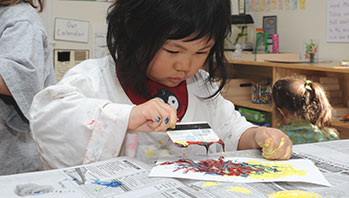- eye droppers
- liquid watercolors
- muffin tins (for paints; one for every pair)
- pipette
- straws (different widths)
- tray to hold paper (keeps the paint from blowing on the table)
- watercolor paper or card stock
- drop
- flow
- puddle
MA Standards:
Language/L.PK.MA.6: Use words and phrases acquired through conversations, listening to books read aloud, activities, and play.
Head Start Outcomes:
Approaches to Learning/Initiative and Curiosity: Demonstrates flexibility, imagination, and inventiveness in approaching tasks and activities.
PreK Learning Guidelines:
English Language Arts/Language 5: Listen to and use formal and informal language.
Moving Watercolors Painting

© Commonwealth of Massachusetts, Department of Early Education and Care (Jennifer Waddell photographer). All rights reserved.
Skill Focus: Creative Expression, Small Motor Skills, Vocabulary
Educator Prep: Before beginning the activity, fill muffin tins with about ½ inch of different colored paints.
Tell children they are going to watch how watercolor paint moves on the page. Explain that when you use watercolor paints, you put water in them. Tell children you put a lot of water in the watercolors they will use so the paint will flow across the page.
Have children work in pairs and use the same paint tin, but have each child make his or her own painting. Demonstrate how to make a watercolor picture.
- Dip one end of a straw into a color and move the straw over the paper.
- Tap the straw on the paper, leaving drops of paint on the page.
- Then put the paint end of the straw close to the paint. Put the clean end in your mouth and blow.
- Move the straw around the page as you blow to move the paint into different patterns.
- You can also have children drop a bigger puddle of paint on the page with the pipette. Then have them make rivers by blowing or dragging the paint across the page. Ask them how this is like the making rivers from the puddles in dirt.
Adaptation: For older children, you may want to have them drop the end of the straw into the paint. Instead of tapping the straw, have them move it to the page and blow through the straw right away.
Educator Tip: You may want to mix up a batch of watery-blue paint in advance and have children share it. Otherwise, some very young children may use too much color and make their paint too thick.
